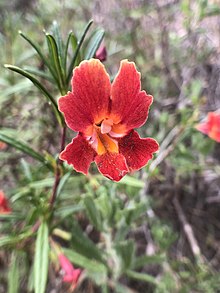
Salvia mellifera is a small, highly aromatic, evergreen shrub of the genus Salvia native to California, and Baja California, Mexico. It is common in the coastal sage scrub of Southern California and northern Baja California. Black sage has a dark appearance, especially during drought.
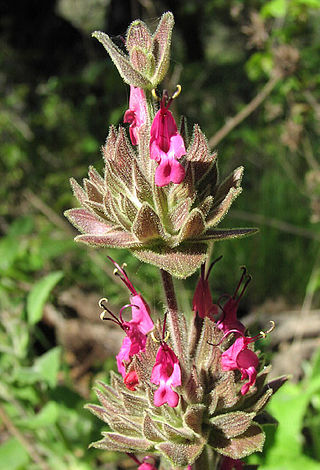
Salvia spathacea, the California hummingbird sage or pitcher sage, is a species of flowering plant in the family Lamiaceae, native to southern and central California growing from sea level to 610 m (2,001 ft). This fruity scented sage blooms in March to May with typically dark rose-lilac colored flowers. It is cultivated in gardens for its attractive flowering spikes and pleasant scent.

Ornithostaphylos is a monotypic plant genus which contains the single species Ornithostaphylos oppositifolia, commonly known as the Baja California birdbush or Baja California manzanita. A large, evergreen shrub in the heather family, this species is near-endemic to northwestern Baja California, with a small population just north of the border in San Ysidro, California. It produces a much-branched inflorescence of white, urn-shaped flowers, and has leathery leaves that appear opposite or in whorls. These characteristics separate it from its close relatives in the region, which include manzanitas (Arctostaphylos), summer holly (Comarostaphylis) and mission manzanita (Xylococcus).
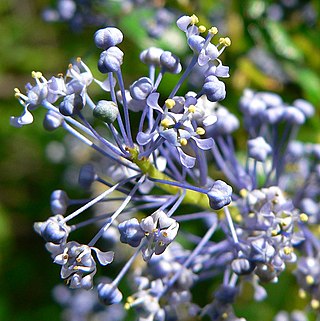
Ceanothus cyaneus is a species of flowering shrub in the genus Ceanothus known commonly as the San Diego buckbrush and Lakeside ceanothus. This species is found in the Peninsular Ranges of San Diego County, California, and known from one occurrence in Baja California. It is characterized by brilliant blue flowers, glossy green foliage, and is regarded as one of the most beautiful members of the genus.

Euphorbia misera is a semi-succulent shrub in the genus Euphorbia commonly known as the cliff spurge or coast spurge. A drought-deciduous shrub, it is typically found as a gnarled, straggly plant occupying seashore bluffs, hills and deserts. Like other members of its genus, it has a milky sap, which can be found exuding out of the light gray bark when damaged. The alternately-arranged leaves are round and folded in the middle, with small hairs on them. The "flowers" can be found blooming year-round, and are colored maroon or yellow in the center with 5 white to light-yellow petal-like appendages attached outside. This species is native to the Baja California peninsula and Sonora in Mexico, and the coast of southern California in the United States, where it is a rare species. It is threatened in some localities by the development of its coastal habitat, which tends to be prime locations for high-end residential and commercial developments.

Lepechinia ganderi is a rare species of perennial shrub in the mint family known by the common name San Diego pitcher sage or Gander's pitcher sage. An aromatic plant with white to lavender flowers, this species is only known from southern San Diego County in California and a small portion of Baja California, occurring on chaparral or coastal sage scrub in metavolcanic soils. Because of its limited range, it is under threat from growing urbanization and increased fire frequency.

Camissoniopsis bistorta is a species of flowering plant in the evening primrose family known by the common names southern suncup and California suncup. It is native to southern California and Baja California, where it grows in several types of plant community along the coast and in the coastal hills and mountain ranges. This is a hairy annual or short-lived perennial herb spreading from a basal rosette, with stems reaching up to 80 centimeters long. The leaves are narrow and sometimes toothed, and 1 to 12 centimeters in length. Toward the end of the spreading stems are nodding inflorescences of flowers, each flower with four bright yellow petals dotted with red at their bases.

Salvia brandegeei is a perennial evergreen shrub in the mint family known by the common names Santa Rosa Island sage or Brandegee's sage. It is a fragrant plant characterized by lavender flowers and dark green leaves. For many years, it was thought to be native only to Santa Rosa Island, one of the Channel Islands of California, until it was discovered along the coast of Baja California. It is threatened by development and mining along the mainland portions of its range, but otherwise has a stable population on Santa Rosa Island.

Hooveria parviflora is a species of perennial herb in the Agave/Yucca subfamily known by the common name smallflower soap plant. It is a monocot, native to coastal southern California and Baja California, where it is a member of the coastal sage scrub flora. It resembles a smaller version of Chlorogalum pomeridianum, with wavy leaves and white flowers that open during the day.

Lonicera subspicata is a species of honeysuckle known by the common name southern honeysuckle. It is native to Baja California, California, and northern Baja California Sur, where it is known from several areas in mountain and coastal habitat, particularly chaparral. It is a vining shrub which usually climbs on other plants for support.
Diplacus clevelandii is an uncommon species of monkeyflower known by the common name Cleveland's bush monkeyflower. It was formerly known as Mimulus clevelandii.

Ribes canthariforme is a rare species of currant commonly known as the Moreno currant. It is characterized by pink to red flowers, a dense inflorescence, and a lack of nodal spines. A little-known endemic to the mountains of San Diego County, it is usually found growing the shade of massive boulders in the chaparral. Although the rarity and small numbers of this plant is a conservation concern, it is usually found in remote areas and is well hidden enough to be safe from most threats.

Salvia munzii is a semi-evergreen perennial species of sage known by the common name Munz's sage or San Miguel Mountain sage. It is native to northern Baja California, Mexico, and it can be found in a few locations just north of the border in San Diego County, California, where it is particularly rare. It is characterized by small leaves and clear blue flowers. It is a member of the coastal sage scrub and chaparral plant communities.

Stemodia durantifolia is a species of flowering plant in the plantain family commonly known as the whitewoolly twintip and purple stemodia. Stemodia durantifolia is native to the Americas, including Chile, Mexico, Texas, and the deserts of California and Arizona, and is often found in riparian habitats, preferring wet sand and rocks. It is a perennial herb producing a hairy, glandular, erect stem 10–100 cm (3.9–39.4 in) tall, with the toothed lance-shaped leaves found in pairs or triplets, attached to the stem with clasping bases. The inflorescence is a raceme of violet flowers, with each corolla held in a calyx of hairy, pointed sepals, and can often be found in bloom year-round. Although globally at low risk of extinction, Stemodia durantifolia is imperiled in California due to its rarity and threats from development.

Dudleya attenuata is a species of perennial succulent plant known by the common name taper-tip liveforever, native to Baja California and a small portion of California. A rosette-forming leaf succulent, it has narrow pencil shaped leaves that can often be found covered in a white epicuticular wax. The thin, sprawling stems branch to form the clusters of rosettes, with plants creating a "clump" up to 40 cm wide. The small flowers are white or yellow, with 5 spreading petals. It is a diverse, variable species that extends from the southernmost coast of San Diego County to an area slightly north of the Vizcaino Desert, hybridizing with many other species of Dudleya in its range. Some plants with white or pinkish flowers were referred to as Orcutt's liveforever, referring to a former subspecies split on the basis of the flower color.

Dicranostegia is a monotypic genus of hemiparasitic flowering plants belonging to the family Orobanchaceae, containing the species Dicranostegia orcuttiana, commonly known as Orcutt's bird's beak or Baja bird's beak. It is near-endemic to Baja California, found from Miller's Landing north to Tijuana, but has a few occurrences in southern San Diego County, California. It is differentiated among other similar species in California by its leaves with 8 to 11 lateral lobes that are paired. It was formerly placed in the genus Cordylanthus until phylogenetic analysis led to it being split off. This species is threatened by the destruction of its habitat from urbanization.
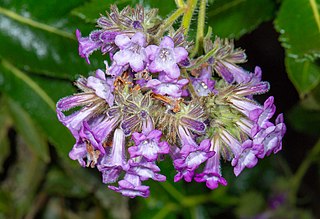
Eriodictyon sessilifolium, known by the common names Baja California yerba santa, sessile-leaved yerba santa or sessileleaf yerba santa is a perennial shrub in the Boraginaceae family, near-endemic to Baja California but also rarely found in the southern California, in a locality near Poway.

Convolvulus simulans is a species of annual plant in the morning glory family known as the small-flowered morning-glory and small-flowered bindweed. It is an inconspicuous vining plant that is characterized by tiny pale pink or pale blue bell-shaped flowers. It is typically restricted to clay and serpentine substrates in annual grassland, coastal sage scrub and chaparral habitats. This species is native to Arizona, California, and Baja California. Some taxonomies place this species under Convolvulus equitans.
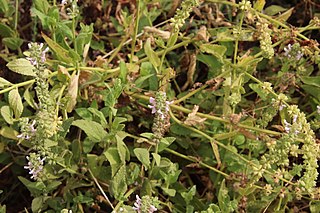
Stachys stebbinsii is a species of perennial herb in the mint family commonly known as Stebbins' hedgenettle. This plant is characterized by a musky aroma, flowers with large lower lips, and glandular hairs that densely cover the stems. S. stebbinsii is native to California and northwestern Baja California. It is usually found growing in moist places in a wide variety of habitats including disturbed areas, chaparral, coastal sage scrub and mountains.

Gambelia juncea is a species of flowering shrub in the plantain family commonly known as the Baja California bush snapdragon or Baja bush snapdragon. Gambelia juncea is a highly variable woody perennial to 1 m (3.3 ft) characterized by long, arching, reed-like stems and showy, bright red, two-lipped tubular flowers. Native to the Baja California peninsula and coastal Sonora, this species is widespread in the region across numerous habitats and has several varieties. It was formerly placed in the primarily South American genus Galvezia, but taxonomic studies have supported the reclassification of the two North American species into Gambelia. This species, with a number of cultivars, is widely used as an ornamental shrub for xeriscaping, erosion control, native plant gardens, and wildlife gardens.
